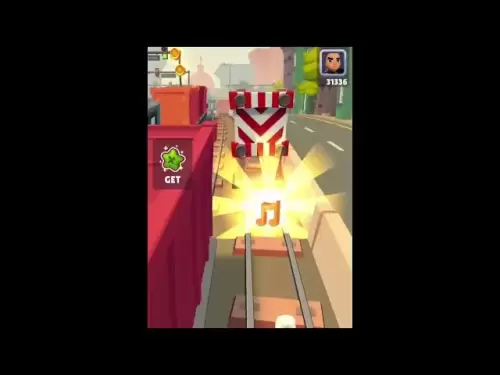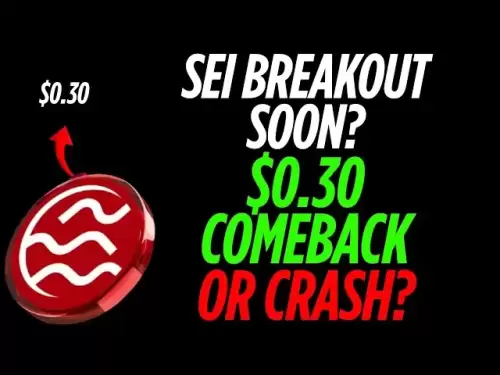-
 Bitcoin
Bitcoin $109,583.2239
0.19% -
 Ethereum
Ethereum $2,583.4612
0.48% -
 Tether USDt
Tether USDt $1.0003
-0.04% -
 XRP
XRP $2.2681
0.70% -
 BNB
BNB $659.9218
-0.52% -
 Solana
Solana $151.4961
-0.37% -
 USDC
USDC $0.9999
-0.02% -
 TRON
TRON $0.2861
1.20% -
 Dogecoin
Dogecoin $0.1718
0.04% -
 Cardano
Cardano $0.5960
-0.07% -
 Hyperliquid
Hyperliquid $40.1233
2.85% -
 Sui
Sui $2.9974
2.48% -
 Bitcoin Cash
Bitcoin Cash $497.1279
-1.76% -
 Chainlink
Chainlink $13.7275
-0.22% -
 UNUS SED LEO
UNUS SED LEO $9.0241
0.70% -
 Avalanche
Avalanche $18.5536
-0.88% -
 Stellar
Stellar $0.2421
1.39% -
 Toncoin
Toncoin $2.8593
-0.51% -
 Shiba Inu
Shiba Inu $0.0...01187
-0.07% -
 Litecoin
Litecoin $90.0023
2.90% -
 Hedera
Hedera $0.1590
2.79% -
 Monero
Monero $322.1495
0.00% -
 Polkadot
Polkadot $3.5453
-1.00% -
 Dai
Dai $1.0000
-0.01% -
 Bitget Token
Bitget Token $4.5733
-1.06% -
 Ethena USDe
Ethena USDe $1.0002
-0.01% -
 Uniswap
Uniswap $7.6345
3.03% -
 Aave
Aave $279.2583
0.47% -
 Pepe
Pepe $0.0...01003
-1.52% -
 Pi
Pi $0.4941
-0.32%
Should I reduce my position when the long upper shadow line tests the previous high pressure level?
A long upper shadow near a previous high suggests resistance and potential reversal, signaling traders to consider reducing position size amid heightened selling pressure and uncertain follow-through.
Jul 03, 2025 at 04:22 pm
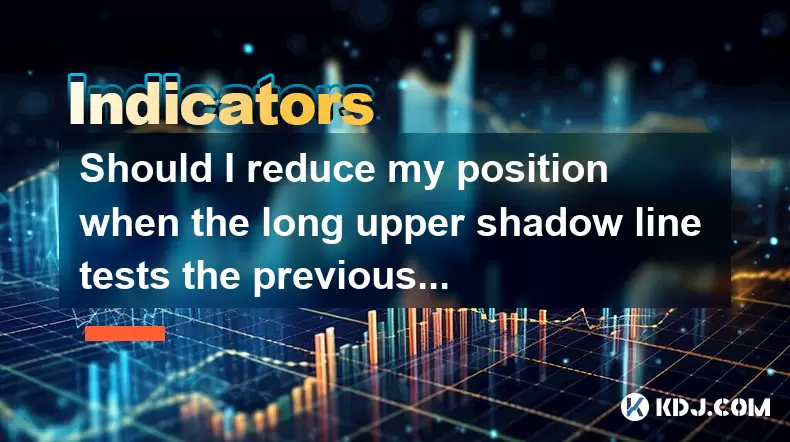
Understanding the Long Upper Shadow Line
A long upper shadow line in candlestick charting typically indicates a potential reversal or resistance at a certain price level. This pattern occurs when the price moves significantly higher during the trading session but then reverses and closes near the opening price, forming a long wick on top of the candle body. This signals that buyers attempted to push prices up but were met with strong selling pressure, which could suggest a rejection of higher levels.
In the context of cryptocurrency markets, where volatility is high and sentiment can shift quickly, recognizing this pattern becomes crucial. When this type of candle appears while testing a previous high, it may indicate that the market is struggling to break through a key resistance zone.
Important: The presence of a long upper shadow alone isn't enough to make a decision — it should be evaluated alongside volume, support/resistance levels, and broader market conditions.
What Is a Previous High Pressure Level?
The term "previous high pressure level" refers to a historical resistance point where the price has previously struggled to move beyond. In crypto trading, these levels are often watched closely by both retail and institutional traders as psychological markers. When the price approaches such a level again, especially after a rally, it can trigger reactions from traders who expect either a breakout or a pullback.
When a long upper shadow forms while retesting a prior high, it suggests that the market is once again rejecting those levels, reinforcing their significance as resistance. This can be particularly relevant in altcoin and Bitcoin charts, where large swings often occur around known technical levels.
Why Traders Consider Reducing Position Size
Traders may consider reducing position size when encountering such a pattern due to several underlying concerns:
- Potential for short-term reversal: A long upper shadow can signal exhaustion among buyers, suggesting a possible correction or consolidation phase.
- Increased risk-reward imbalance: If the price fails to break past a known resistance level, the upside potential may become less attractive compared to the downside risk.
- Liquidity considerations: Cryptocurrency markets can experience sudden liquidity crunches, especially at key technical zones, making exits difficult if a reversal occurs rapidly.
Reducing position size allows traders to manage risk more effectively without necessarily exiting entirely. It's a tactical adjustment rather than a full reversal of position.
How to Evaluate Market Context Before Making a Decision
Before deciding whether to reduce your position, it's essential to evaluate the broader market environment. Consider the following factors:
- Trend alignment: Is the current move part of an uptrend, downtrend, or sideways consolidation? A long upper shadow in a healthy uptrend may not carry the same weight as one in a weakening trend.
- Volume analysis: Did the candle with the long upper shadow form on high volume or low volume? High volume may suggest stronger conviction behind the rejection, whereas low volume might imply indecision.
- Correlation with major assets: In crypto, Bitcoin often sets the tone for altcoins. If BTC is also showing similar patterns, it could reinforce the need for caution.
Each of these elements contributes to a clearer understanding of whether the long upper shadow is a meaningful warning sign or just a temporary pause in momentum.
Practical Steps to Reduce Position Safely
If you decide to reduce your position, here are practical steps to execute the move safely:
- Set limit orders instead of market orders: Especially in volatile markets like crypto, using limit orders helps avoid slippage and ensures better execution.
- Monitor order book depth: Check the bid-ask spread and available liquidity before placing trades to ensure smooth execution.
- Use partial profit-taking: Instead of closing the entire position, consider taking profits on a portion (e.g., 30–50%) to preserve capital while still allowing for potential upside.
- Maintain stop-loss placement: Adjust stop-loss levels accordingly to protect remaining holdings without being prematurely exited.
These steps help maintain discipline and prevent emotional decision-making during critical price action moments.
Frequently Asked Questions
Can I use other indicators to confirm the strength of the long upper shadow?
Yes, combining candlestick patterns with tools like RSI, MACD, or moving averages can offer additional confirmation. For instance, if the RSI is overbought and starts to roll over at the same time as the long upper shadow forms, it reinforces the bearish signal.
Is it safe to re-enter after reducing my position?
Re-entry depends on how the price behaves after the rejection. Watch for signs of renewed buying interest, such as bullish engulfing candles, increased volume, or a successful retest of the previous high. Never assume a bounce will happen immediately.
Does this strategy apply equally to all cryptocurrencies?
While the principle applies broadly, market cap and liquidity differences mean that smaller-cap altcoins may exhibit more erratic behavior. Higher volatility and lower liquidity can lead to false signals or exaggerated candle formations.
Should I always act on a long upper shadow at resistance?
No, context is key. If the overall trend remains intact and supporting fundamentals haven't changed, a single candle shouldn't dictate your entire strategy. Use it as a warning, not a command.
Disclaimer:info@kdj.com
The information provided is not trading advice. kdj.com does not assume any responsibility for any investments made based on the information provided in this article. Cryptocurrencies are highly volatile and it is highly recommended that you invest with caution after thorough research!
If you believe that the content used on this website infringes your copyright, please contact us immediately (info@kdj.com) and we will delete it promptly.
- Crypto's Wild Ride: TOKEN6900, SPX6900, and the S&P 500 Connection
- 2025-07-04 03:50:13
- LUNA Crypto Collapse: From Billions Lost to a Quiet Comeback?
- 2025-07-04 02:35:18
- Briber's Four Forces: Decoding the Dynamics of Crypto Incentives
- 2025-07-04 02:35:18
- Solana DeFi Accumulation: Riding the Wave or Just HODLing On?
- 2025-07-04 02:40:12
- ZKasino's $30M Rug Pull: Founder Arrested in UAE – Justice Served?
- 2025-07-04 00:30:13
- Bitcoin's Bull Run: Standard Chartered and the ETF Inflow Effect
- 2025-07-04 00:30:13
Related knowledge
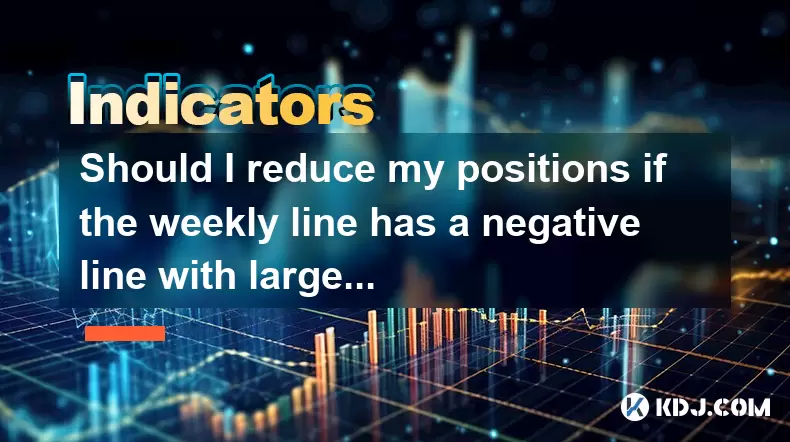
Should I reduce my positions if the weekly line has a negative line with large volume + the daily line falls below the middle Bollinger line?
Jul 01,2025 at 10:50pm
Understanding the Weekly Line with Negative Candle and Large VolumeWhen analyzing cryptocurrency charts, a weekly line that forms a negative candle accompanied by large volume is often interpreted as a strong bearish signal. This pattern suggests that institutional or large traders are actively selling their positions, which can foreshadow further price...
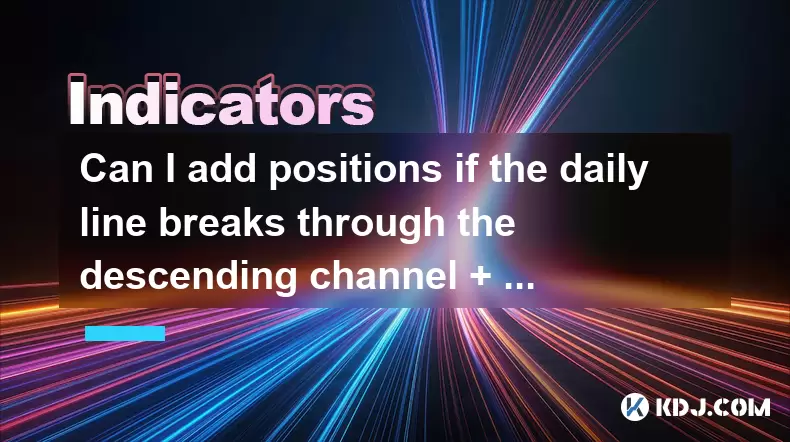
Can I add positions if the daily line breaks through the descending channel + the 30-minute moving average is in a bullish arrangement?
Jun 30,2025 at 11:00pm
Understanding the Descending Channel BreakoutWhen a daily line breaks through a descending channel, it indicates a potential shift in market sentiment from bearish to bullish. A descending channel is formed by drawing two parallel trendlines, where the upper trendline connects the lower highs and the lower trendline connects the lower lows. A breakout o...
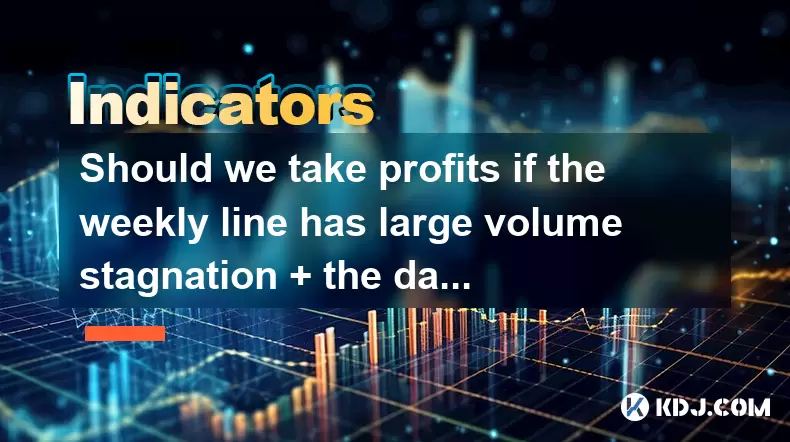
Should we take profits if the weekly line has large volume stagnation + the daily RSI top divergence?
Jul 01,2025 at 05:22pm
Understanding Weekly Volume Stagnation in Cryptocurrency TradingIn cryptocurrency trading, weekly volume stagnation refers to a situation where the total trading volume over a week remains relatively flat or shows no significant increase despite price movements. This phenomenon can indicate that institutional or large traders are not actively participat...
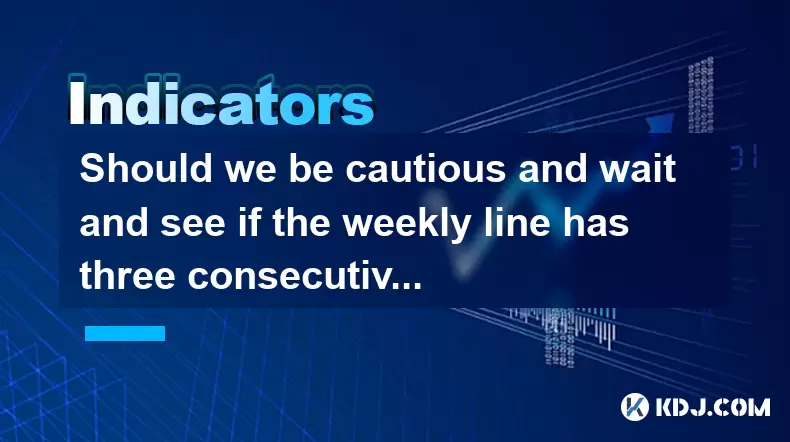
Should we be cautious and wait and see if the weekly line has three consecutive Yin lines + the daily MACD green column enlarges?
Jul 01,2025 at 12:42am
Understanding the Weekly Three Consecutive Yin Lines PatternIn technical analysis, three consecutive Yin lines on a weekly chart indicate a strong bearish trend. Each Yin line represents a week where the closing price is lower than the opening price, signaling consistent selling pressure. When this pattern appears three times in succession, it often sug...
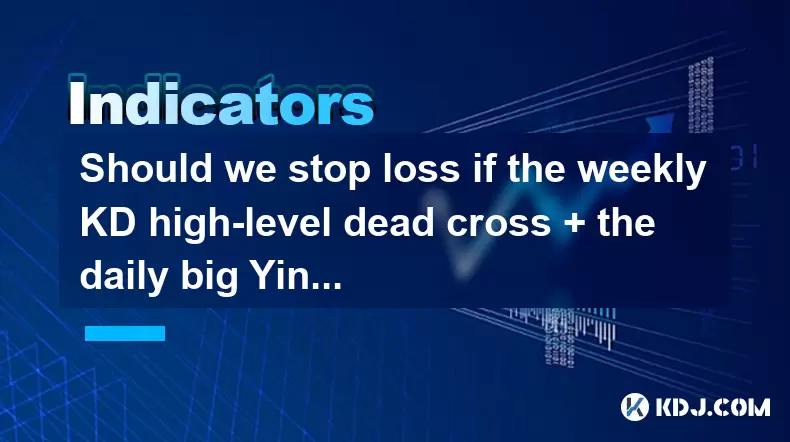
Should we stop loss if the weekly KD high-level dead cross + the daily big Yin line breaks?
Jul 01,2025 at 09:49pm
Understanding the Weekly KD High-Level Dead CrossIn technical analysis, KD (K-D indicator) is a momentum oscillator that helps traders identify overbought or oversold conditions in the market. The weekly KD high-level dead cross occurs when both the K-line and D-line are above 80 (indicating overbought territory), and the K-line crosses below the D-line...
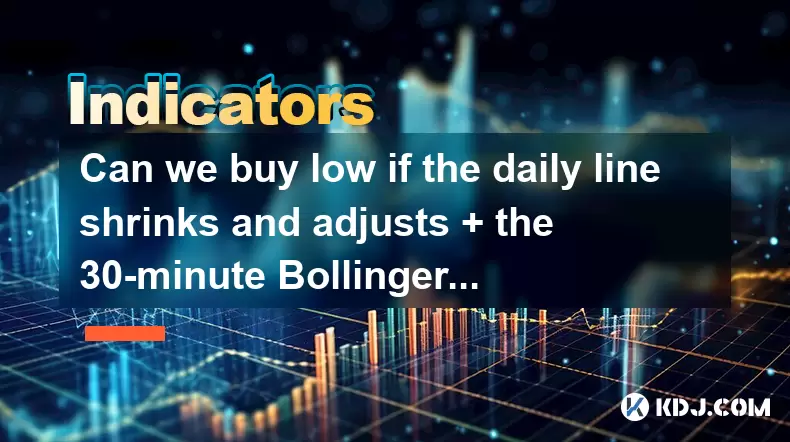
Can we buy low if the daily line shrinks and adjusts + the 30-minute Bollinger lower rail supports?
Jul 02,2025 at 12:29pm
Understanding the Technical Indicators: Bollinger Bands and Daily Line ShrinkingIn cryptocurrency trading, technical indicators play a critical role in identifying potential entry and exit points. The Bollinger Bands consist of a moving average (typically 20 periods) and two standard deviation lines plotted above and below it. When prices touch or appro...

Should I reduce my positions if the weekly line has a negative line with large volume + the daily line falls below the middle Bollinger line?
Jul 01,2025 at 10:50pm
Understanding the Weekly Line with Negative Candle and Large VolumeWhen analyzing cryptocurrency charts, a weekly line that forms a negative candle accompanied by large volume is often interpreted as a strong bearish signal. This pattern suggests that institutional or large traders are actively selling their positions, which can foreshadow further price...

Can I add positions if the daily line breaks through the descending channel + the 30-minute moving average is in a bullish arrangement?
Jun 30,2025 at 11:00pm
Understanding the Descending Channel BreakoutWhen a daily line breaks through a descending channel, it indicates a potential shift in market sentiment from bearish to bullish. A descending channel is formed by drawing two parallel trendlines, where the upper trendline connects the lower highs and the lower trendline connects the lower lows. A breakout o...

Should we take profits if the weekly line has large volume stagnation + the daily RSI top divergence?
Jul 01,2025 at 05:22pm
Understanding Weekly Volume Stagnation in Cryptocurrency TradingIn cryptocurrency trading, weekly volume stagnation refers to a situation where the total trading volume over a week remains relatively flat or shows no significant increase despite price movements. This phenomenon can indicate that institutional or large traders are not actively participat...

Should we be cautious and wait and see if the weekly line has three consecutive Yin lines + the daily MACD green column enlarges?
Jul 01,2025 at 12:42am
Understanding the Weekly Three Consecutive Yin Lines PatternIn technical analysis, three consecutive Yin lines on a weekly chart indicate a strong bearish trend. Each Yin line represents a week where the closing price is lower than the opening price, signaling consistent selling pressure. When this pattern appears three times in succession, it often sug...

Should we stop loss if the weekly KD high-level dead cross + the daily big Yin line breaks?
Jul 01,2025 at 09:49pm
Understanding the Weekly KD High-Level Dead CrossIn technical analysis, KD (K-D indicator) is a momentum oscillator that helps traders identify overbought or oversold conditions in the market. The weekly KD high-level dead cross occurs when both the K-line and D-line are above 80 (indicating overbought territory), and the K-line crosses below the D-line...

Can we buy low if the daily line shrinks and adjusts + the 30-minute Bollinger lower rail supports?
Jul 02,2025 at 12:29pm
Understanding the Technical Indicators: Bollinger Bands and Daily Line ShrinkingIn cryptocurrency trading, technical indicators play a critical role in identifying potential entry and exit points. The Bollinger Bands consist of a moving average (typically 20 periods) and two standard deviation lines plotted above and below it. When prices touch or appro...
See all articles





















